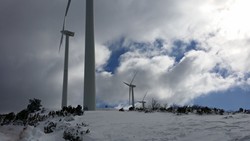The tide turns for offshore maintenance costs
The cost of attending to routine maintenance, so as to keep turbines running under all weather conditions, accounts for about half the yearly costs of an offshore wind farm. Other expensive costs are associated with the import of electric power needed to keep systems operational while a turbine is shut down. The goals of EU-funded research carried out within the project HYDROBOND (New cost/effective superhydrophobic coatings with enhanced bond strength and wear resistance for application in large wind turbine blades) were directed at reducing both preventative or routine and unscheduled maintenance costs. Maintenance is invariably expensive, and the loss of electricity production, while the work is carried out, can have an adverse effect on the profitability of an offshore wind farm. Longer distance to shore, particularly because the aim is to access higher winds, may outweigh the benefits of an increase in energy yields. Super-hydrophobic coatings In the HYDROBOND consortium, companies and research institutions joined their efforts to develop new super-hydrophobic coatings, which can also be used against ice formation, as well as their application. Significant advances in coatings for wind turbine blades were made using a cold gas spray process. Current coatings are thermo-sprayed onto different industrial components. Tiny ‘nano-sized’ powder particles are semi-melted and propelled towards a substrate or surface area, onto which they are hardened to form a coating. Post-coating work is needed to minimise internal tensile stresses developed during solidification. Project partners optimised and tailored solid state technology and paints for cold gas spraying to the wind industry. Particles are accelerated at the substrate at speeds many times the speed of sound to achieve the necessary plasticity that enables deformation. Their speed is, however, not too high to avoid them bouncing off the substrate rather than bonding to it. The team also achieved significant improvements in the powder composition. In the past, only metallic substrates were used for cold gas spraying. Thanks to HYDROBOND research, composites reinforced with nano/microceramic materials (among others) can be sprayed onto a whole range of substrates – both metallic and non-metallic. ‘To combine hydrophobicity, anti-icing and wear resistance was a challenge from the beginning of the project since there was no material on the market that delivered the desired multifunctionality of wind blade surface,’ stresses Professor Josep Maria Guilemany, HYDROBOND coordinator from the Thermal Spray Centre at the University of Barcelona in Spain. The new coating technique eliminates the need for expensive active anti-icing processes that remove ice from wind turbine blades by heating. The new super-hydrophobic coatings act like passive systems since they prevent the formation of the ice. Pushing emissions and costs down ‘According to our estimations, a reduction of more than 30 million tonnes of carbon dioxide (CO2) emissions can be achieved over a period of four years after the implementation of the new super-hydrophobic coatings on turbine blades,’ notes Prof. Guilemany. He adds that ‘since less maintenance will be needed, transport to offshore wind farms will be reduced as well as subsequent damage to marine habitat. Furthermore, higher efficiency of offshore wind turbines will render them more attractive than onshore wind farms.’ The first industrial demonstrations have already begun, and patents are being secured before HYDROBOND technologies are made available on the market.
Keywords
Wind turbines, nanoparticles, onshore wind farm, offshore wind farm, HYDROBOND, super-hydrophobic







